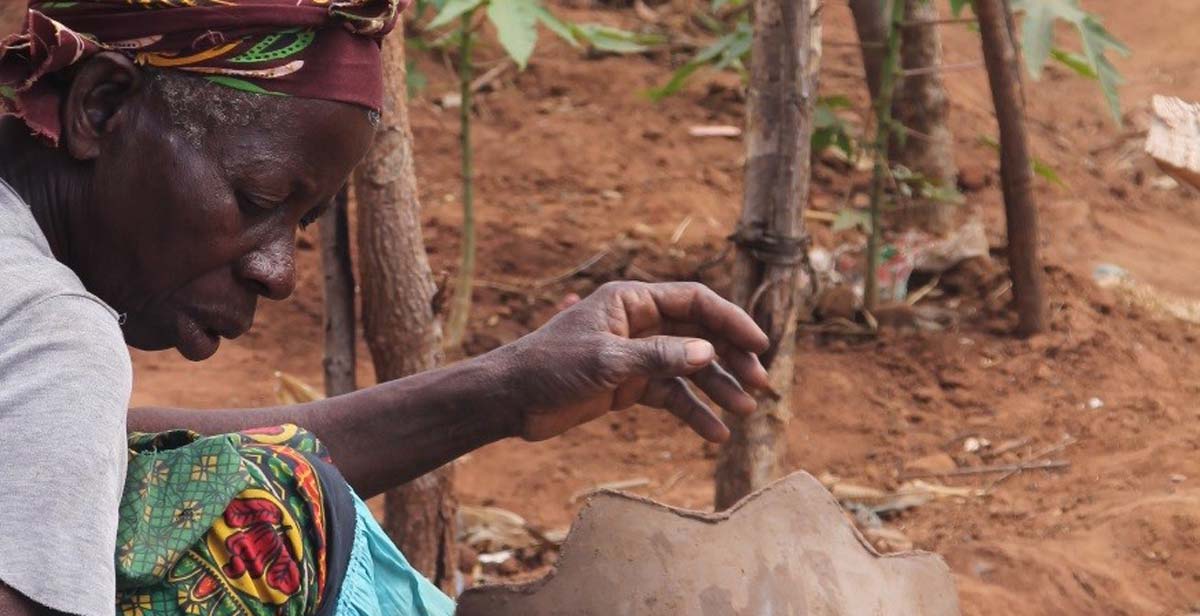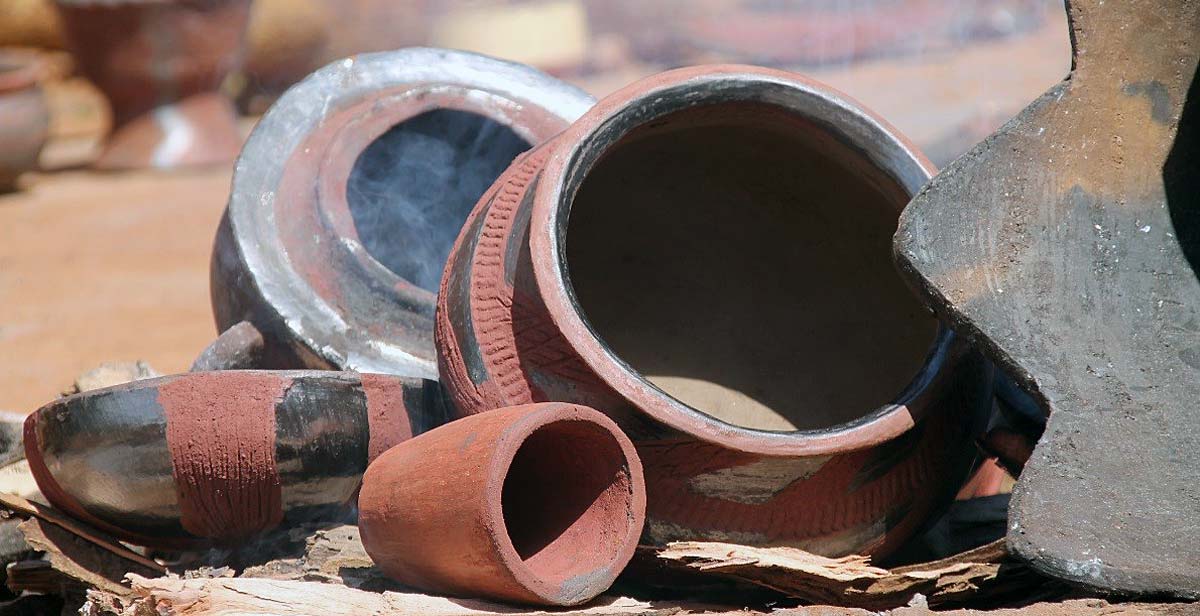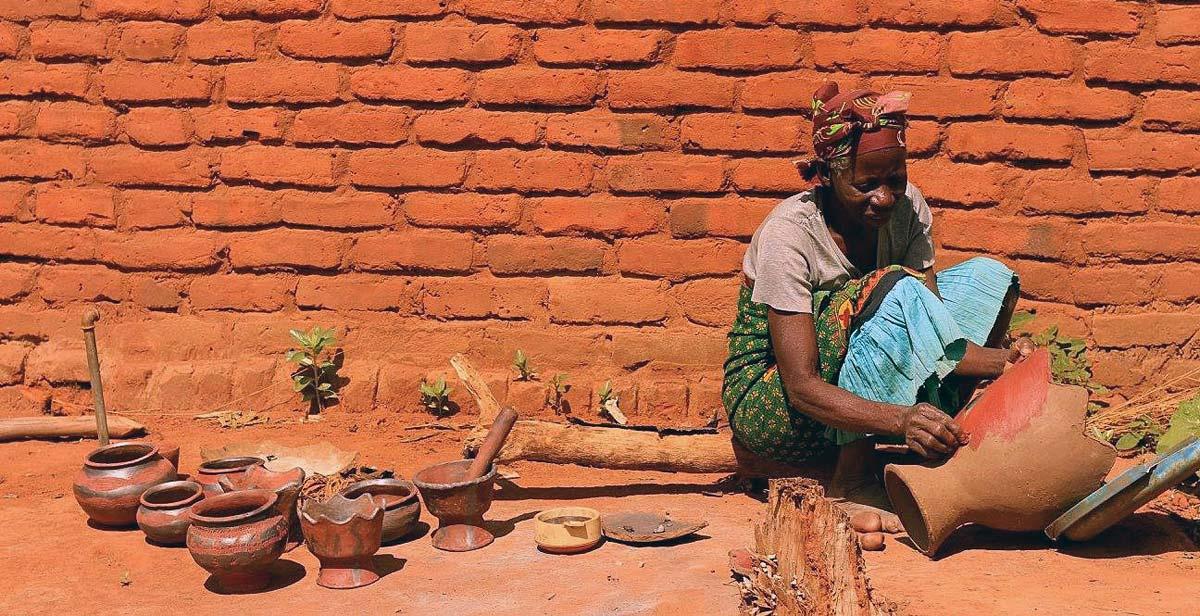A few weekends ago we set out in the early morning to visit a Malawian potter. We met Micki outside her small brick house surrounded by her pots laid out for our investigation. She had a whole range of items spread on the sandy floor, from traditional beer drinking vessels, to larger flower vases which are liked by local lodges. After a round of compulsory hand shaking and introductions, Micki led us to the shell of her neighbour’s house where she currently works, due to the shade provided by the half structure. We sat down on a bamboo mat whilst Micki proceeded to demonstrate her craft, and we peppered her with questions about her life and profession.
We discovered that Micki used to be a business woman trading and selling rice, whilst making pots on the side for her friends and family. It was Micki’s parents who taught her pottery, passing on their techniques whilst she was just a child. Her parent’s methods were used to create huge vessels, big enough for two people to stand in, and used to collect and store water. As these vessels are largely redundant nowadays, due to the availability of plastic, Micki has adapted her parent’s teachings to create pieces on a smaller scale. Around 10 years ago her business collapsed and she was left with nothing, without even enough money for soap. It was at this point she started making pots full-time, and although it is tough, her new trade allows her to scrape together a living to get by. Micki sells her work to local businesses and lodges as well as at the market in Rumphi, which she visits every couple of weeks, after building up enough stock to make the stall fee worth the money.

After watching Micki effortlessly create a beer drinking vessel it was then my turn to make a pot using her traditional methods, and with lots of help! We started by squishing together handfuls of clay from her bucket, making sure the two clays that she had already kneaded were definitely combined well. Clays which she had dug locally from two separate locations, and then mixed to create a final clay of greater strength. First, we flattened the clay into a disk shape to form a base. Then we flattened two further pieces bringing them together to form an upright cylinder with a solid base. To join the clay sections we used a firm squidging action, moving clay across the join. We used the same action to add additional coils of clay on top of one another, building up the cylindrical form. The next step was to scrape the clay surface upwards at a diagonal angle with a maize cob, rotating the pot after each stroke. Once the surface clay seemed thoroughly blended we then used a mango stone on the inside of the cylinder to shape the vessel, pushing the form outwards into a bulbous shape. Finally we smoothed the outside of the pot with a piece of carved wood and added a rim by joining a thin coil around the top of the piece.
We left the pot to firm up in the sunshine for about 20 minutes, after which we patterned the pot using a small twig plucked off the sandy floor. After chatting with the huge crowd of neighbours who had gathered to see the wazungu (white people) and promising to come back the following week for the firing, we headed home, covered in clay and glad to have learnt new skills.
The next weekend we arrived back at Micki’s to help with the firing. We came just as the pots were being placed on top of the burning wood, after which they were covered fully with large pieces of palm bark. Micki then lit dried grass and poked this into the bottom of the fire to increase the internal temperature. After about an hour the palm bark had burnt away and Micki then hooked the pots out of the embers with a long stick. She then beat them with leaves before rubbing red slip onto the surface. It was so satisfying seeing the pot I helped to make in its finished state, ready to be used!

Before leaving we chatted with Micki again, and discovered that although she used to enjoy her craft, it is now just a way to survive. Every time she makes pots she gets joint pains in her hands, and so once she has saved enough money to replace her grass roof with a metal one, she will retire and let her daughter take over the pottery business. It was so sad to hear this, but we still left on a happy note with Micki giving us a big smile and wishing for us to visit again in the future.
Written by ICS volunteer Emily Stapleton Jefferis



